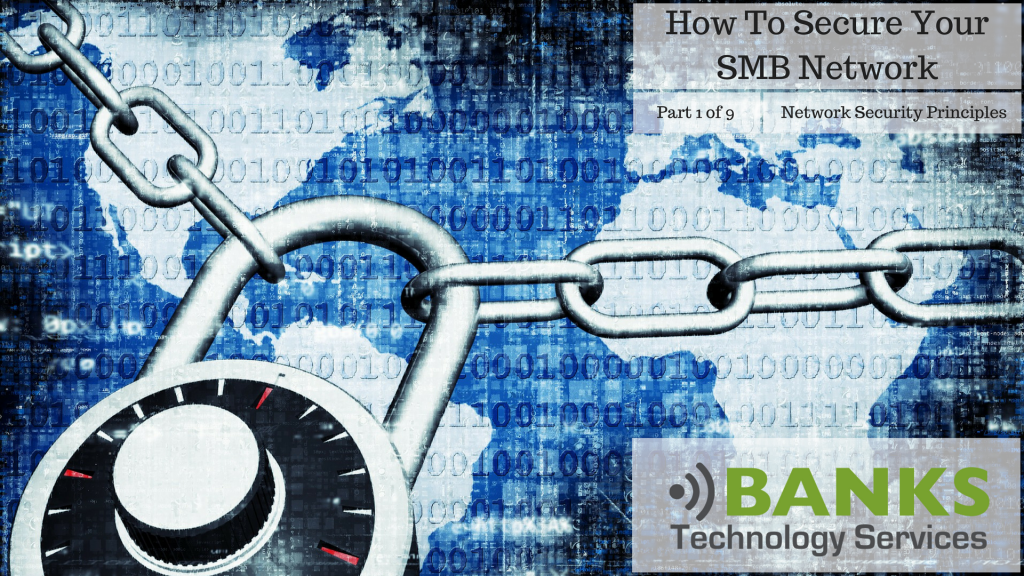Welcome to How To Secure Your SMB Network! This is part 1 of a 9 part series that discusses our approach to Network Security and how we secure client networks. As you will see there are many facets that go into creating a secure network. Think of it as a puzzle with each piece playing an important role. The days of installing Norton Anti-Virus on your computer and thinking you are safe are over.
Layered Approach to Network Security
Our philosophy takes a layered approach to network security. No one solution solves the problem, it takes various products, devices, solutions, and software that all work together to secure an environment.
Unified Threat Management
First, we start at the edge or perimeter of your network by using Unified Threat Management (UTM) Gateways to keep threats from entering your network. Having UTM hardware at the perimeter of your network will keep most Malware, Viruses, and Ransomware from entering your network in the first place.
Content and URL Filtering
Next, we apply Content and URL filtering to your workstations. This prevents access to websites that contain known threats and networks used by Ransomware, Malware, and Viruses to transmit their files. Some exploits (specifically encrypting Ransomware) work by installing a small undetectable program on the computer. That program then attempts to download and install a “payload”. This payload is what does the damage to your computer. If the computer is not able to access the network hosting the malicious payload, the exploit becomes relatively harmless.
Software Restriction Policies
Another layer in our approach is using Software Restriction Policies to limit what programs can run on your network. Most businesses use only a handful of programs on a regular basis. The idea is to “Whitelist” these common programs so that they run without restriction. Programs that are not Whitelisted will need a special Username and Password to run, or they are blocked from running. This essentially blocks malicious programs from running in the background without your permission.
Endpoint Security and Anti-Spam
Moving on, Endpoint Security and Anti-Spam solutions are deployed to all devices on your network. Endpoint Security is installed on every workstation and server. Anti-Spam may placed at the edge of your network or in the cloud, so that email is filtered before it even enters your network.
Patching and Updates
Our patching and update systems are used to quickly (and quietly) install needed updates and patches to your systems and software, without interrupting your end users. Occasionally vendors will release patches that need to be deployed quickly to protect against a rapidly spreading threat. Our systems make this process simple and pain free.
Administrative Rights
Lastly, we restrict Administrative Rights to limit the attack surface of malicious threats. This means that your employees will use a restricted user account. This normally doesn’t cause any interruption to most people’s daily work. If a user needs the ability to install programs, run manual updates, change settings etc. we provide a separate username and password they can enter to temporarily have these permissions. The result is any malicious code that executes can only execute at the restricted user permission level. This alone will stop the vast majority of threats.
Catered Approach
Every solution we provide is catered to the individual business. While this article details our general approach, every business is different and has different needs. Some software packages require you to have Administrative Rights to run the program. Sometimes business owners want to use Content and URL Filtering to restrict access to Facebook or Monster.com. Some businesses, often branch offices of larger companies, have very specific requirements placed on them by Corporate IT departments. We always take into account your specific needs when implementing our network security solutions.
How To Secure Your SMB Network – E-Book
 This is the first part of a nine part series that details How To Secure Your SMB Network. Every Wednesday we will post a new section that gives details and examples on how Banks Technology Services secures out client’s networks. We have compiled all of this information into into an EBook which you can download for free. The E-Book contains additional information, real world examples, and is updated as new technology emerges. To receive your FREE copy, head on over to the [intlink id=”7985″ type=”page”]How To Secure Your SMB Network[/intlink] page.
This is the first part of a nine part series that details How To Secure Your SMB Network. Every Wednesday we will post a new section that gives details and examples on how Banks Technology Services secures out client’s networks. We have compiled all of this information into into an EBook which you can download for free. The E-Book contains additional information, real world examples, and is updated as new technology emerges. To receive your FREE copy, head on over to the [intlink id=”7985″ type=”page”]How To Secure Your SMB Network[/intlink] page.
[content_band style=”color: #333;” bg_color=”#f3f3f3″ border=”all” inner_container=”true”] [custom_headline style=”margin-top: 0; align:center;” level=”h3″ looks_like=”h3″ ]How To Secure Your SMB Network Blog Series[/custom_headline]
Part 1 – Network Security Principles
Part 2 – UTM Gateyway
Part 3 – Content Filtering
Part 4 – Software Restriction Policies
Part 5 – Spam Filtering
Part 6 – Endpoint Security
Part 7 – Patching
Part 8 – Administrative Rights
Part 9 – Conclusion[/content_band]


